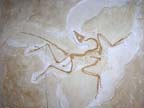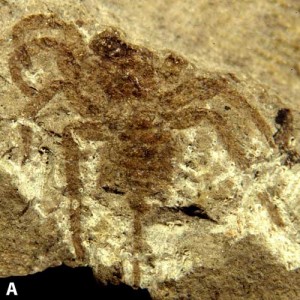 |
 |
 |
 |
 |
Produced
by the Population Genetics and Evolution class, Furman University |
||||
 |
 |
 |
 |
 |
Produced
by the Population Genetics and Evolution class, Furman University |
||||
 |
The
Devonian: Attercopus |
 |
||
| Attercopus
fimbriungus was once believed to be the oldest-known true spider
(Strickland 2008). Recent analysis, however, showed that what was believed
to be the spinneret, the silk-producing structure that is the distinguishing
feature of modern spiders, was not a spinneret at all (Sheldon, Shear,
and Sutton 2008). Instead, they had two rows of spigots on plates located
along the underside of their abdomen (Sheldon, Shear, and Sutton 2008).
Another of the many other differences between Attercopus and
modern spiders is the presence of a long tail (ScienceDaily 2009). With
this reexamination, as well as the discovery of other spider-like organisms
that also have spigots and tails, Attercopus fimbriungus has
since been re-identified as a protospider, representing an important link
in spider evolution (Sheldon, Shear, and Sutton 2008). Attercopus
could produce sheets of silk but, without the precision that spinnerets
would provide, was unable to spin webs (ScienceDaily 2009). They possibly
used the silk to line burrows, to guide themselves back to safety in a
retreat, or to cover egg sacs (Sheldon, Shear, and Sutton 2008). Web building
would seem unlikely since flying insects would not appear until much later
in time (Strickland 2008). Page by Lin Lin Zhao |
 |
| Fossil of Attercopus fimbriungus, a protospider. Photo Credit: Smithsonian.com | |
|
ScienceDaily. 2009. How the spider spun its web: ‘missing link’ in spider evolution discovered. Accessed February 22, 2010. Sheldon PA, Shear WA, and Sutton MD. 2008. Fossil evidence for the origin of spider spinnerets, and a proposed arachnid order. PNAS 105: 20781-20785. Strickland E. 2008. Spider ancestor made silk—possibly using it for sex—but couldn’t spin a web. www.discovermagazine.com. Accessed February 22, 2010. |